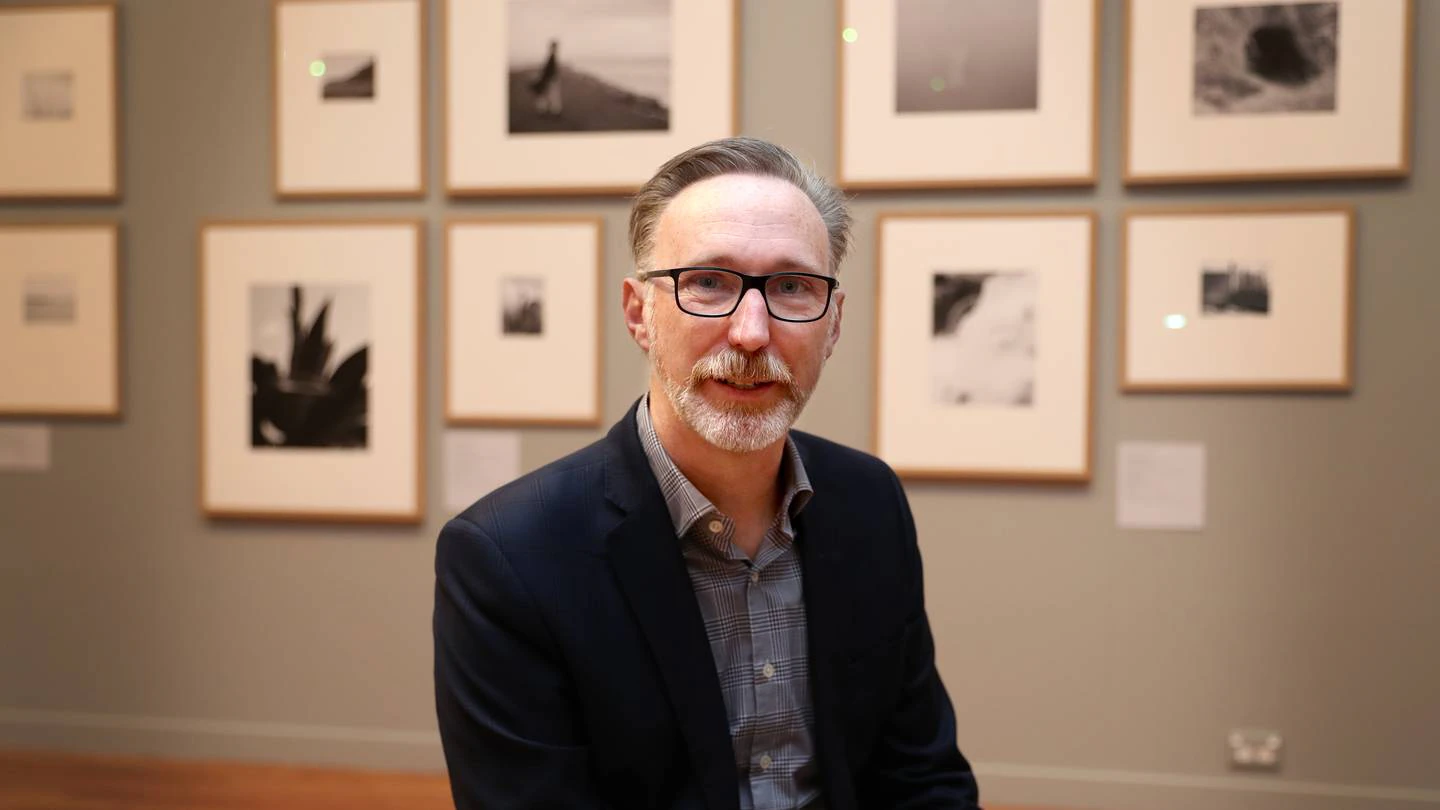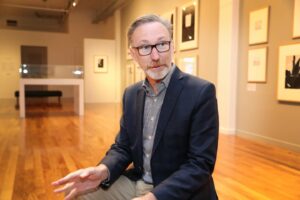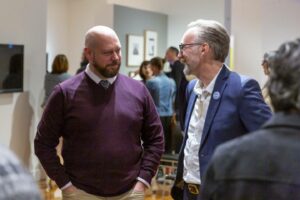
11 Apr ‘What we have here tells the story of Whanganui’: Meet the new Sarjeant Gallery director Andrew Clifford
New director Andrew Clifford wants the Sarjeant Gallery to be an integral part of the city and its development, writes Zaryd Wilson.
Andrew Clifford likens the first task in his new job to landing a plane.
The new director of Sarjeant Gallery Te Whare o Rehua Whanganui has arrived in the role with a little over a year until it reopens at its Pukenamu Queen’s Park home.
That follows a more than decade-long redevelopment project under former director Greg Anderson.
Clifford’s appointment comes at one of the most significant times in the gallery’s 104-year history and while he may not have flown the plane to this point, he has to find the tarmac safely.
“I guess it’s my job to take the legacy of everything that’s been done so far and work with the team… towards that great moment next year.”
He’s been here before.
When Clifford began his previous job as director of Te Uru Waitākere Contemporary Gallery in 2014, it was a new dawn.
Te Uru was born out of a gallery within Lopdell House in Titirangi which started in the 1980s.
But in 2012 work began to restore the heritage building, build a new wing and create what is now the nationally significant Te Uru in West Auckland.
“It was an organisation that was about to go through a really big growth spurt,” Clifford says.
“I don’t think anyone realised how big that was except for those on the inside at the time.
“It was a chance to relaunch an organisation within a whole new context, in a large building, which has a dramatic impact on a community and a dramatic change in what the institution can do.”
A first artistic love
While his family origins were in Auckland his mother’s siblings were scattered around the country with his closest cousins in Whanganui.
Clifford spent his childhood in Hastings.
“I don’t know if it’s the city or just being a kid that makes it seem idyllic in memory. Hastings has changed a lot after we left but at the time it was a pretty happy little town, a flat city to tear around on your bicycle, head of the movies… or whatever you wanted to do.”
He moved to Auckland as he was hitting his teens and went to Selwyn College where his first artistic love – music – began to grow.
“I mean I guess I could retrospectively identify those points at school when I was drawing and stuff but I think that’s just something kids do,” Clifford says.
“It was music that kept me involved in the arts.”
His mum played piano, he did piano lessons and he sang in church but he says it was older friends who cultivated his music taste.
“We had this big house in Hastings and we always had boarders who were always teens who had just left home and not quite gone flatting and they were always listening to music.
“Because I’m the oldest I don’t have that classic story of the big brother who introduced me to his records but I think these older people that I knew kind of took that role.”
If that piqued Clifford’s artistic interest, it was Selwyn College that embedded it.
“It was a very liberal school,” Clifford says.
It had a strong theatre and arts department, great teachers, and “half” the school orchestra “ended up being the future members of Supergroove”.
“And there’s a long list of musicians who went through Selwyn around that time who ended up in well-known bands.”

Clifford says the Sarjeant should be an integral part of the city Photo Bevan Conley
‘Everyone wants to be an artist initially’
Clifford left school thinking he’d make his way in the music world. He hung out at bFM, did an audio engineering course and began writing about music and art.
And that’s where the drift into what he calls “arts infrastructure” began.
He went to Elam School of Fine Arts “having a clear sense I wasn’t studying as an artist anymore”.
“I went back to study as more of a curator within an arts school.
“I mean I make the comparison with the film world: everyone wants to be a star actor or a producer – those are the two things that everyone knows.
“Everyone wants to be an artist initially but there are other roles. You watch all the credits at the end of the film, somehow people find a way into those very obscure and specialist career paths.
“I think it’s really important that artists just focus on doing what they do which is making the work. People who work in the arts who aren’t artists are the facilitator to present that work to the public. Somehow it has to come out into the world.”
Clifford later ended up running the Gus Fisher Gallery at the University of Auckland from 2007 learning the “nuts and bolts of the day-to-day operation of a gallery”.
Te Uru followed.
After almost 10 years there Clifford says he could have easily stayed on and that he was a “through-and-through Aucklander” with no real plan to leave.
But then Anderson resigned from the Sarjeant last year to take the role of deputy director of operations at Auckland Art Gallery.
“When this came up I thought ‘this might be the time’.”
Now, Clifford and his wife Karen have signed a lease on a property in Gonville, and “there’ll be a point in a couple of weeks when the truck arrives with all our worldly possessions and then there’ll be that sense of permanence”.
“It’s a really unique opportunity and aside from the Sarjeant and the job itself, I’ve been aware for a number of years that things are happening in Whanganui.
Clifford wants a part of it.
“You’re kind of curating the institution rather than its exhibitions and that means how that institution connects with its community,” Clifford says.
“That’s a much bigger project. You’re really part of the development of a city rather than the development of a gallery and I’ve increasingly found that really interesting.”
Once the development is complete, what are Clifford’s plans for the gallery?
“I mean, there are really interesting bones here and it’s not so much about changing but building on that.”
One thing will be to start purchasing art for the gallery’s collection again.
“And then there’s the general aspiration that this becomes one of the major galleries in New Zealand and people coming to New Zealand will come to Whanganui.
“Making sure what we’re doing is part of the national conversation of what’s happening in New Zealand contemporary art.”
Clifford says while the Sarjeant has a place in the local arts sector, it needs that much broader outlook.
“You do have to ride that tightrope. You don’t want to become parochial and only show local artists to local people.
“I always compare it to a library. You don’t want to go into a library and only have local writers. Local writers want to be able to read books from all around the world.
“If you’re coming to Whanganaui you want a Whanganui experience and that’s got to be part of what people find here but also it needs to be nationally and internationally relevant and of a standard and the local artists that do get to show here will benefit of being part of something bigger.
“You can’t include everybody and not everybody’s at that level yet. You just need to think about how the gallery works as part of that ecosystem.”
Clifford also wants the Sarjeant to become “an integral part of the city” and get people into the gallery.
“I think in New Zealand we’ve not been as strong at supporting the arts as we could be.
“As kids we all draw, we’re all artists. But at some point, you get taken on some other path and you don’t have access to the arts like you do other things. It somehow slips out of our everyday reality.”
Clifford said embedding iwi involvement in the gallery was also a priority.
That had started with iwi co-design and co-governance supporting the development of the new wing, Pātaka o Sir Te Atawhai Archie John Taiaroa.
“It means iwi stories are embedded in the building itself – I think that a really good foundational step. It means it’s their building as much as anyone else’s, we’re not just asking them to endorse what we’re doing – it needs to be their place too.”

Whanganui District Council chief David Langford and Sarjeant Gallery director Andrew Clifford. Photo Supplied
A return on investment
Multiple budget blowouts have the final redevelopment cost pushing $70 million. But with ratepayers funding around 25 per cent of that, Clifford calls it “a huge return on a local investment.”.
“It’s still not going to be for everyone and public infrastructure is like that. Not everyone wants to use the swimming pool and not everyone wants to use the cycling track but these are all important things for a city to have.
“It’s one of the cultural resources alongside parks and other sorts of things.
“On a more commercial level, being one of the best in the country, it’s going to be a great tourist attraction, and whether you personally visit it or not lots of people from elsewhere will be and it’s just going to generate a huge amount of economic activity that everyone will benefit from.
“But I think fundamentally it’s about wellbeing and creativity and, like the museum, what we have here tells the story of Whanganui and you need to hang onto those stories.
“You’ve got to have a sense of where you’re from if you’re going to understand where you’re going.”
By Zaryd Wilson
This article first appeared in the Whanganui Chronicle on April 8, 2023.

